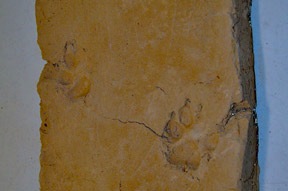The Dog-Prints Go Down: Traditional Wisdom in Adobe Laying
Ed Crocker
In my former incarnation as technical director for Cornerstones Community Partnerships, I had many inspiring occasions to visit with and work alongside residents in many of New Mexico's rural communities. One of the ironies that the staff frequently encountered is re-introducing traditional yet forgotten building methods to villagers whose direct ancestors developed or refined the technologies to begin with. It was not at all uncommon for a community member who had just relearned how, for example, to prepare native clays for a decorative surface to comment "I knew that! I watched my grandmother do it that way."
When the west wall of the San José mission in Upper Rociada, New Mexico collapsed because of moisture retention caused by a hard render, there was never a doubt in the minds of the mayordomo, or lay caretaker, and his committee that the wall would be rebuilt. The question and its qualification were; "How? We've been building with wood for two generations now." When the slumped wall was being dismantled by hand, many questions about adobe technology arose. There was a profound curiosity about the wooden corner ties, the embedded scaffolding supports at six feet from grade, and the coursing of the adobes. During this process, the community resolved to duplicate as closely as possible the work of their forebears for two reasons: The techniques were successful, and their replication implied a real sense of cultural continuity. When all of the preparatory work had been done and the first of some ten thousand adobe bricks were waiting to be laid, there was a pause to invoke the blessing of San José, patron saint of the church, and a longer delay to decide just how to begin. I was present throughout the process and the only hesitation that I perceived came at that moment. No one in the community knew (or remembered) how to lay adobes.
 A year before the Upper Rociada experience, I held an adobe repair workshop in the community of Chacón, some 40 miles north. The group that I was assisting on this occasion numbered six, and ranged in age from 9 to 15. As we stood in front of a stack of adobes I asked the usual introductory question, "Now, who knows which side of an adobe goes up?" This always elicits remarks such as "it doesn't matter," "the top," or my favorite, "the side with the dog-prints on it." There was a girl of 12 in the group who, on hearing the flippant responses, stated firmly,"The dog-prints go down." As I explored her answer I found that she alone of the group had helped her father and grandfather lay adobes. Though she couldn't tell me why, she had the correct answer.
A year before the Upper Rociada experience, I held an adobe repair workshop in the community of Chacón, some 40 miles north. The group that I was assisting on this occasion numbered six, and ranged in age from 9 to 15. As we stood in front of a stack of adobes I asked the usual introductory question, "Now, who knows which side of an adobe goes up?" This always elicits remarks such as "it doesn't matter," "the top," or my favorite, "the side with the dog-prints on it." There was a girl of 12 in the group who, on hearing the flippant responses, stated firmly,"The dog-prints go down." As I explored her answer I found that she alone of the group had helped her father and grandfather lay adobes. Though she couldn't tell me why, she had the correct answer.
When the wooden forms that adobe bricks are cast in are lifted away from the fresh mud, the upper margins of the brick are dragged upwards. This configuration remains in the finished product and results in a slightly concave cross-section occasionally exacerbated by passing canines. The bottom, at the time of casting, is flat or even slightly convex, the result of slumping when the partly-dried brick is turned on edge to dry faster. When laying the brick, the top becomes the bottom so that the concave side seats firmly in the mud mortar. When the course above is added, the adobe laid in this manner is less likely to shift than is the adobe set with its convex side down.
I speculate that single-wythe walls certainly, and multiple-wythe walls (depending on the coursing pattern) may, when laid according to traditional wisdom, remain drier as well. Moisture introduced to the top of the wall is inclined, during its downward migration, to follow the interface of the brick and its mortar. In a wall laid "right side up" the moisture would be inclined to accumulate in the central mass, in the "bowls" of the brick. Conversely, water would be directed outwards, to the inside and outside surfaces where it can evaporate from walls laid with "the dog-prints down."

